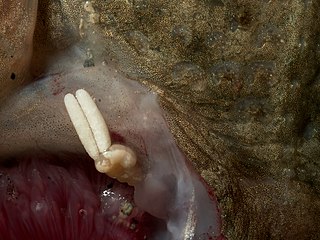
Digenea is a class of trematodes in the Platyhelminthes phylum, consisting of parasitic flatworms with a syncytial tegument and, usually, two suckers, one ventral and one oral. Adults commonly live within the digestive tract, but occur throughout the organ systems of all classes of vertebrates. Once thought to be related to the Monogenea, it is now recognised that they are closest to the Aspidogastrea and that the Monogenea are more closely allied with the Cestoda. Around 6,000 species have been described to date.
Galactosomum is a genus of flukes in the family Heterophyidae. There are currently 28 recognised species within the genus. They mainly infect aquatic birds, but often infest fish as larvae. Three species are known to use marine mammals as hosts.

Plagiorchiida is a large order of trematodes, synonymous to Echinostomida. They belong to the Digenea, a large subclass of flukes. This order contains relatively few significant parasites of humans.

Chondracanthidae is a family of parasitic copepods, usually found infecting the branchial chamber of demersal fishes. It comprises the following genera:

Rhadinorhynchidae is a family of parasitic worms from the order Echinorhynchida.

Tinea is a genus of the fungus moth family, Tineidae. Therein, it belongs to the subfamily Tineinae. As evident by its name, it is the type genus of its subfamily and family. Established as one of the first subgroups of "Phalaena", it used to contain many species of Tineidae that are nowadays placed in other genera, as well as a few moths nowadays placed elsewhere.

Opisthorchiidae is a family of digenean trematodes. Opisthorchiidae have cosmopolitan distribution.

Opecoelidae is a family of trematodes. It is the largest digenean family with over 90 genera and nearly 900 species, almost solely found in marine and freshwater teleost fishes. It was considered by Bray et al. to belong in the superfamily Opecoeloidea Ozaki, 1925 or the Brachycladioidea Odhner, 1905.
Cainocreadium is a genus of trematodes in the family Opecoelidae. It has been synonymised with Apopodocotyle Pritchard, 1966, Cainocreadoides Nagaty, 1956, and Emmettrema Caballero y Caballero, 1946.
Decemtestis is a genus of trematodes in the family Opecoelidae. It has been synonymised with Allodecemtestis Hafeezullah, 1970.
Podocotyloides is a genus of trematodes in the family Opecoelidae.
Philophthalmidae is a family of trematodes in the order Plagiorchiida.

Echinostomatidae is a family of trematodes in the order Plagiorchiida, first described in 1899.
Pedunculacetabulum is a genus of trematodes in the family Opecoelidae.

Peniculus is a genus of marine copepods in the family Pennellidae. They occur worldwide and typically parasitize coastal or epipelagic fish, with the exception of Peniculus hokutoae that was found parasitizing a mesopelagic myctophid, Symbolophorus evermanni.

Seitarō Gotō (1867–1935) was a Japanese scientist, known for his works on the Monogenea, a class of parasitic flatworms which are ectoparasites of fishes. He also worked on other invertebrates, such as Coelenterates and Echinoderms.
Metamicrocotyla is a genus which belongs to the family Microcotylidae and class Monogenea. It was created by Yamaguti in 1953 to include Metamicrocotyla bora and Metamicrocotyla filiformis from the gills off the flathead grey mullet Mugil cephalus (Mugilidae). As all Monogenea, species of Metamicrocotyla are ectoparasites that affect their host by attaching themselves as larvae on the gills of the fish and grow into adult stage. This larval stage is called oncomiracidium, and is characterized as free swimming and ciliated. Members of Metamicrocotyla are characterized by a symmetrical haptor, a variable number of postovarian testes and with no cirrus nor vagina. their genital atrium is provided with paired groups of spines or hooks.
Cryptogonimidae is a family of trematodes belonging to the order Plagiorchiida.
Catatropis is a genus of trematodes belonging to the family Notocotylidae.

Echinostomatinae is a subfamily of trematodes in the order Plagiorchiida, first described in 1899.









